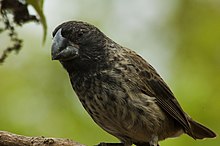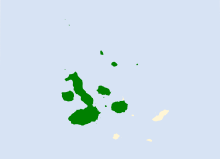368:
380:
31:
196:
75:
50:
397:
245:
The feather and bill colors vary between males and females. The adult male is mostly black, with slightly browner wings and tail; the cloaca is white-streaked; the eyes are dark brown. It also has blackish legs. The tail is relatively short. An adult female has browner feathers compared to a male,
331:
Usually, before displaying in front of a female, the male builds several nests. Once the male forms a pair, the female often occupies herself by building another nest or by completing one initiated by the male. Large ground finches usually stay within the vicinity of their nests if foraging is
254:
It has a large beak, having a thick base of lower mandibles and curved culmen. It allows the bird to feed on large seeds and insects, but also to crack and consume nuts. Thanks to its versatile beak, the large ground finch often has a variety of food supplies. Moreover, the shape of the
343:
The large ground finch's voice differ from other finches due to the shape and structure of its bill. Normally, the male sings only one song type, a nasal repetition consisting of 2-3 notes. The call is higher-pitched, resembling the sound "tzeeeeppp".
259:
gives the finch slower and lower-pitched sounds and more nasal calls. Similar to other male finches, the beak changes color in relation to different periods: it's black during the breeding season, but turns amber outside the period.
328:
Normally, the shape of their nests is round-shaped with lateral entrance, and they are built in cacti or in bushes 3-9 meters above the ground. The nest is made of twigs, dry grasses and lichens.
335:
The breeding season starts shortly after the first rains and egg laying occurs mostly during high rainfall periods. The female finch lays four eggs and the hatching occurs in about 12 days.
246:
sometimes with yellow-brown or grey outer edges; scaled patterns are found going up the body; most parts of the torso and the head are streaked with brown and pale yellow shades.
242:
The large ground finch weighs about 27-39 g, and its length ranges slightly 15-16 cm. It is the largest species of Darwin's finch both in total size and size of beak.
379:
842:
700:
739:
832:
674:
713:
401:
718:
847:
744:
551:
578:
300:
They keep a small territory and build nests within. Competition for food is intense during the breeding season.
276:, and is found in the arid zone of most of the archipelago, though it is absent from the southeastern islands (
367:
757:
617:
612:
320:. They search for food most of the time on the ground. The adults feed their chicks mainly with insects.
450:
591:
74:
752:
796:
285:
705:
599:
513:
308:
The large ground finches have diverse food options. They eat mainly large seeds, and also pick
731:
565:
791:
487:
407:
169:
783:
661:
604:
560:
8:
223:
39:
427:
809:
317:
313:
69:
281:
837:
778:
635:
273:
640:
445:
627:
30:
765:
353:
352:
Large ground finch is widespread in its area. Although the species is extinct on
289:
277:
356:, the population appears to be stable. The species currently is not threatened.
826:
726:
536:
436:
312:
cactus fruits, caterpillars and large insects. They usually feed on seeds of
59:
54:
385:
One of Darwin's finches. Charles and
Chatham Islands, Galapagos Archipelago.
195:
770:
687:
545:
231:
804:
679:
227:
185:
126:
86:
692:
653:
507:
530:
219:
146:
106:
586:
309:
269:
136:
666:
573:
396:
96:
648:
419:
256:
215:
116:
408:
https://www.oiseaux-birds.com/card-large-ground-finch.html
425:
451:10.2305/IUCN.UK.2016-3.RLTS.T22723729A94830750.en
824:
234:. It is the largest species of Darwin's finch.
263:
194:
48:
29:
449:
226:, it is now placed in the tanager family
323:
843:Endemic birds of the Galápagos Islands
825:
512:
511:
482:
480:
478:
476:
474:
472:
470:
468:
833:IUCN Red List least concern species
437:IUCN Red List of Threatened Species
13:
14:
859:
465:
395:
378:
366:
316:and, less commonly, on seeds of
73:
426:BirdLife International (2016).
338:
237:
1:
412:
295:
7:
10:
864:
359:
303:
520:
347:
193:
175:
168:
70:Scientific classification
68:
46:
37:
28:
23:
444:: e.T22723729A94830750.
390:
264:Habitat and Distribution
230:and was formerly in the
848:Birds described in 1837
249:
810:Geospiza-magnirostris
792:Paleobiology Database
579:geospiza-magnirostris
566:Geospiza_magnirostris
552:Geospiza magnirostris
522:Geospiza magnirostris
492:www.oiseaux-birds.com
430:Geospiza magnirostris
404:at Wikimedia Commons
402:Geospiza magnirostris
211:Geospiza magnirostris
179:Geospiza magnirostris
488:"Large Ground-Finch"
324:Nesting and breeding
161:G. magnirostris
40:Conservation status
24:Large ground finch
373:Large ground finch
318:Bursera graveolens
314:Tribulus cistoides
214:) is a species of
206:large ground finch
820:
819:
779:Open Tree of Life
514:Taxon identifiers
400:Media related to
274:Galapagos Islands
202:
201:
63:
855:
813:
812:
800:
799:
787:
786:
774:
773:
761:
760:
748:
747:
735:
734:
722:
721:
709:
708:
696:
695:
683:
682:
670:
669:
657:
656:
644:
643:
631:
630:
621:
620:
608:
607:
595:
594:
592:3646336BDD9A461E
582:
581:
569:
568:
556:
555:
554:
541:
540:
539:
509:
508:
502:
501:
499:
498:
484:
463:
462:
460:
458:
453:
423:
399:
382:
370:
224:Darwin's finches
198:
181:
78:
77:
57:
52:
51:
33:
21:
20:
863:
862:
858:
857:
856:
854:
853:
852:
823:
822:
821:
816:
808:
803:
795:
790:
782:
777:
769:
766:Observation.org
764:
756:
751:
743:
738:
730:
725:
717:
712:
704:
699:
691:
686:
678:
673:
665:
660:
652:
647:
639:
634:
626:
624:
616:
611:
603:
598:
590:
585:
577:
572:
564:
559:
550:
549:
544:
535:
534:
529:
516:
506:
505:
496:
494:
486:
485:
466:
456:
454:
424:
420:
415:
393:
386:
383:
374:
371:
362:
354:Floreana Island
350:
341:
326:
306:
298:
266:
252:
240:
189:
183:
177:
164:
72:
64:
53:
49:
42:
17:
16:Species of bird
12:
11:
5:
861:
851:
850:
845:
840:
835:
818:
817:
815:
814:
801:
788:
775:
762:
749:
736:
723:
710:
697:
684:
671:
658:
645:
632:
622:
609:
596:
583:
570:
557:
542:
526:
524:
518:
517:
504:
503:
464:
417:
416:
414:
411:
392:
389:
388:
387:
384:
377:
375:
372:
365:
361:
358:
349:
346:
340:
337:
325:
322:
305:
302:
297:
294:
265:
262:
251:
248:
239:
236:
200:
199:
191:
190:
184:
173:
172:
166:
165:
158:
156:
152:
151:
144:
140:
139:
134:
130:
129:
124:
120:
119:
114:
110:
109:
104:
100:
99:
94:
90:
89:
84:
80:
79:
66:
65:
47:
44:
43:
38:
35:
34:
26:
25:
15:
9:
6:
4:
3:
2:
860:
849:
846:
844:
841:
839:
836:
834:
831:
830:
828:
811:
806:
802:
798:
793:
789:
785:
780:
776:
772:
767:
763:
759:
754:
750:
746:
741:
737:
733:
728:
724:
720:
715:
711:
707:
702:
698:
694:
689:
685:
681:
676:
672:
668:
663:
659:
655:
650:
646:
642:
637:
633:
629:
623:
619:
614:
610:
606:
601:
597:
593:
588:
584:
580:
575:
571:
567:
562:
558:
553:
547:
543:
538:
532:
528:
527:
525:
523:
519:
515:
510:
493:
489:
483:
481:
479:
477:
475:
473:
471:
469:
452:
447:
443:
439:
438:
433:
431:
422:
418:
410:
409:
405:
403:
398:
381:
376:
369:
364:
363:
357:
355:
345:
336:
333:
329:
321:
319:
315:
311:
301:
293:
291:
287:
286:San Cristóbal
283:
279:
275:
271:
261:
258:
247:
243:
235:
233:
229:
225:
221:
218:in the genus
217:
213:
212:
207:
197:
192:
187:
182:
180:
174:
171:
170:Binomial name
167:
163:
162:
157:
154:
153:
150:
149:
145:
142:
141:
138:
135:
132:
131:
128:
127:Passeriformes
125:
122:
121:
118:
115:
112:
111:
108:
105:
102:
101:
98:
95:
92:
91:
88:
85:
82:
81:
76:
71:
67:
61:
56:
55:Least Concern
45:
41:
36:
32:
27:
22:
19:
521:
495:. Retrieved
491:
455:. Retrieved
441:
435:
429:
421:
406:
394:
351:
342:
339:Vocal sounds
334:
330:
327:
307:
299:
267:
253:
244:
241:
210:
209:
205:
203:
178:
176:
160:
159:
147:
18:
753:Neotropical
688:iNaturalist
546:Wikispecies
457:12 November
332:necessary.
238:Description
232:Emberizidae
827:Categories
805:Xeno-canto
497:2024-01-07
413:References
228:Thraupidae
137:Thraupidae
296:Behaviour
222:. One of
155:Species:
93:Kingdom:
87:Eukaryota
838:Geospiza
732:22723729
706:11336090
605:22723729
600:BirdLife
531:Wikidata
290:Santa Fé
282:Española
278:Floreana
220:Geospiza
148:Geospiza
133:Family:
107:Chordata
103:Phylum:
97:Animalia
83:Domain:
60:IUCN 3.1
758:lagfin1
680:5231036
667:1050334
654:lagfin1
628:lagfin1
587:Avibase
537:Q923644
360:Gallery
310:Opuntia
304:Feeding
272:to the
270:endemic
143:Genus:
123:Order:
113:Class:
58: (
797:371379
784:589955
719:560239
618:120623
574:ARKive
348:Status
288:, and
268:It is
188:, 1837
771:79030
745:48885
701:IRMNG
649:eBird
641:3FSC3
625:BOW:
391:Links
186:Gould
740:NCBI
727:IUCN
714:ITIS
693:9477
675:GBIF
613:BOLD
459:2021
442:2016
292:).
257:bill
250:Beak
216:bird
204:The
117:Aves
662:EoL
636:CoL
561:ADW
446:doi
829::
807::
794::
781::
768::
755::
742::
729::
716::
703::
690::
677::
664::
651::
638::
615::
602::
589::
576::
563::
548::
533::
490:.
467:^
440:.
434:.
284:,
280:,
500:.
461:.
448::
432:"
428:"
208:(
62:)
Text is available under the Creative Commons Attribution-ShareAlike License. Additional terms may apply.

